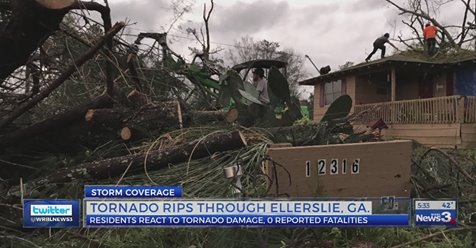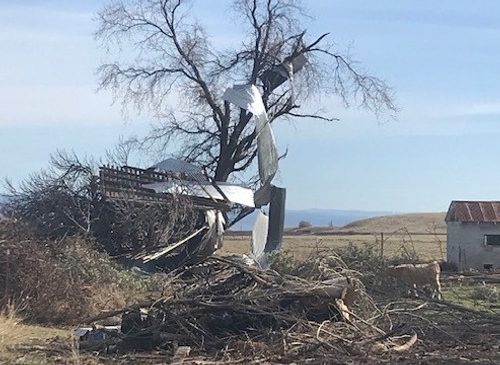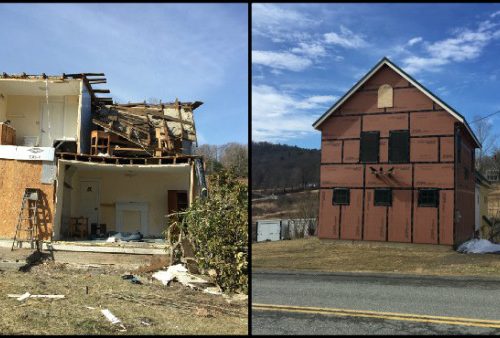Ten years ago this Tuesday, multiple tornadoes tore through western Massachusetts, killing three people, injuring 200, and causing more than $200 million in damages.
The most violent of the tornadoes touched down at 4:17 p.m. in Westfield, churning into West Springfield, then Springfield, leaving streets blanketed with rubble and broken glass, road signs twisted, entire sides of buildings sheared off, and roofs punctured or missing.
Marisol Mendez was working at Springfield Technical Community College that day, stripping and waxing floors. Although the safest place in a tornado is in the interior of a building in the basement, she and her co-workers first peered out big windows on the seventh floor to get a view.
“Like a big cloud! Going around and twirling and I said, ‘Oh wow! It’s going that way. It’s going toward where my mother is!’ ” she said.
Her mother lived in the South End near where the MGM casino would later be built.
“So, when they told us, ‘Go,’ I headed that way,” she said. “I headed toward the tornado like I was chasing the tornado.”
Her mother was safe.
In that same neighborhood, attorney Laura Marino earlier had heard tornado warnings on the radio.
“I sort of paid attention, but not so much,” Marino said. “I did feel a weird, eerie feeling because the color of the sky was this yellowish grayish tint that I had not ever seen before.”
But she ignored it and went to work — that is, until late afternoon.
“I hear this loud thump on the side of the building,” she said. “The other woman who worked in the other office came in running and said a branch just came through the window. And I grabbed my employees and I ran them downstairs to the basement.”
Her employees were worried about their kids, but Marino told them “stay here and be safe.”
It felt like an eternity down there, she said, but it was over in minutes.
“Then we went and opened the front door and it was like a disaster area,” Marino said. “It looked like a bomb had hit it and people were screaming in the streets — mothers, you know, worrying about their children.”
Two people died in West Springfield, one in Brimfield. Insurance claims totaled $175 million. FEMA paid out more than $80 million.
160 Miles Per Hour
A few hours after the storm, National Weather Service meteorologist Joe Dellicarpini started reviewing initial damage reports. He said the tornado first touched down in Westfield, at nearly 80 miles per hour.
“Then it began to strengthen as it approached and moved through downtown Springfield — winds in excess of 100 miles per hour. And then it strengthened even further as it moved toward Monson and Brimfield. And that’s where the maximum damage was observed,” said Dellicarpini. “Wind speeds were estimated near 160 miles per hour.”
It finally lifted in Charlton at 5:27 p.m., after an hour and 10 minutes of destruction.
Dellicarpini said that day there was a rare combination of tornado ingredients: the region’s typical hot, humid air, along with dry air coming all the way from the Southwest in a high pressure system that rotated the air clockwise.
“That air was being forced up into New England, if you can picture that,” Dellicarpini said. “So, it came from the desert southwest of New Mexico, in through Texas and then through Arkansas, Tennessee, and then up here into the Northeast, while at the same time we had a very strong jet stream coming out of southern Ontario.”
A jet stream is a band of strong wind that brings a dose of high energy to weather systems.
All of that “really helps the development become almost explosive in nature,” Dellicarpini said. “And that’s why we had such a big severe weather day here in Massachusetts.”
When Could It Happen Again?
The state gets, on average, one to two tornadoes a year. But highly destructive ones are rare. Fifty-eight years before the Springfield tornado, one killed 90 people in Worcester. There have been other deadly ones, in West Stockbridge, Great Barrington and another in Worcester County.
Dellicarpini said it could be five or 50 years before we see another one with as much force as the one in 2011.
Brian Tang, who studies severe weather at the University of Albany, said most of the tornadoes in the Northeast are relatively weak. There have been only a handful of violent ones to use to evaluate long-term trends.
“Because tornadoes, particularly strong tornadoes like the Springfield tornado, don’t occur frequently,” Tang said. “It’s very hard to say, you know, whether they are increasing or not.”
Tang said looking at the next 50 to 100 years, with projections of a changing climate, we can expect to have more days with enough heat and humidity that could lead to severe weather.
“Now, that being said, whether we get more tornadoes on those days is a completely separate question, because tornadoes are even rarer than having severe weather in the Northeast,” Tang said.
These rare events still cannot be predicted way in advance. The exact location can only be forecast a half-hour or less before a tornado hits.
But warning systems are better now. Unlike in 2011, anyone with a smart phone now receives severe weather alerts.
Springfield And Its ‘Pretty Resilient People’
Laura Marino, who ignored the tornado warnings she heard on the radio 10 years ago, said next time she’ll listen, and pay attention to her own inner voice.
“I feel like I’m much more reliant on my own gut instincts and my own sense of things than I used to be,” she said.
After the tornado, Marino faced the huge task of repairing her building and cleaning up debris. And she advised people in her neighborhood how to get insurance payments to repair their tarp covered, boarded up houses.
“We were all kind of pulled together, like we’re human. Maybe the differences didn’t matter so much,” Marino said. “And thereafter, I just feel like the people in Springfield are pretty resilient people . They’re tough. And I feel like people just picked up and kept it pushing.”
Kept it pushing. Carrying on, despite the loss.
by Nancy Eve Cohen (2021, June 1) WBUR News





